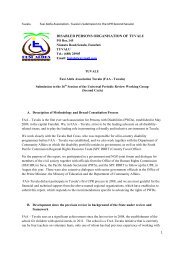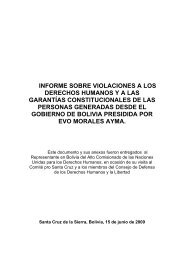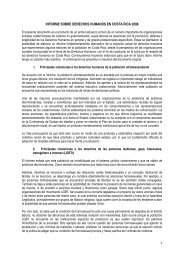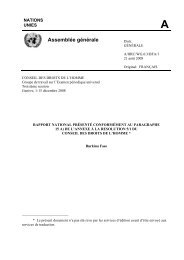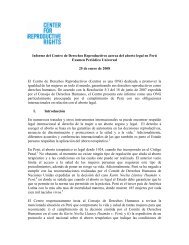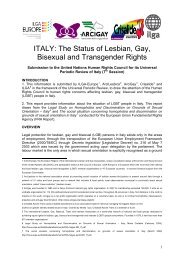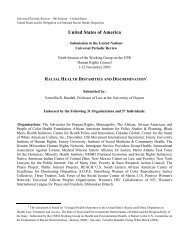Prison Needle Exchange: Lessons from a Comprehensive Review ...
Prison Needle Exchange: Lessons from a Comprehensive Review ...
Prison Needle Exchange: Lessons from a Comprehensive Review ...
You also want an ePaper? Increase the reach of your titles
YUMPU automatically turns print PDFs into web optimized ePapers that Google loves.
1994, found that 6.9% of all participants, and 13% of women with a history of injection<br />
drug use, were HIV-positive. 27<br />
• A study released in 2004 of 1617 prisoners in seven provincial institutions in Québec<br />
found an HIV prevalence rate of 2.3 percent among men and 8.8 percent among women. 28<br />
Other countries<br />
High rates of HIV infection among prisoners are not limited to European and North<br />
American jurisdictions. Countries in all parts of the world are also struggling to address this<br />
health crisis. In Africa, reports have cited that as many as 41% of the 175,000 people in South<br />
African prisons are living with HIV or AIDS. 29 Zambia 30 and Nigeria 31 have also reported<br />
high rates of HIV in their prisons. In Latin America, studies have shown HIV prevalence<br />
rates of almost 7% in three urban prisons in Honduras (with almost 5% of males aged 16 to<br />
20 testing positive) 32 and between 10.9 to 21.5% in a selection of Brazilian prisons. 33 In Asia,<br />
numerous studies in Thailand have shown a history of imprisonment to be significantly associated<br />
with HIV infection. 34 A study of 377 prisoners in three prisons in India found that<br />
6.9% were living with HIV, all of these individuals being originally <strong>from</strong> Thailand and<br />
Myanmar. 35<br />
HCV infection<br />
HCV infection is endemic among prison populations worldwide. In many countries, the high<br />
rates of HIV infection among the prison population are eclipsed by even higher rates of HCV<br />
infection, another bloodborne viral infection that can be transmitted via needle sharing.<br />
Published studies of HCV in the prison setting include those <strong>from</strong> Australia, Taiwan, India,<br />
Ireland, Denmark, Scotland, Greece, Spain, England, Brazil, the United States, and Canada.<br />
The vast majority of peer-reviewed published studies have found that between 20% and 40%<br />
of prisoners are living with HCV and, within study samples, rates of HCV prevalence among<br />
prisoners who inject drugs are routinely two to three times higher than among prisoners who<br />
have no history of injection drug use. 36 It has been suggested that<br />
the concentration of HCV-infected individuals in prisons may be<br />
related to a number of factors, including high rates of incarceration<br />
among people who inject drugs and among those with previous or<br />
multiple imprisonments; and that imprisonment may be an independent<br />
risk factor for contracting HCV infection. 37<br />
In Canada, 23.6% of federal prisoners who underwent voluntary HCV testing in 2001<br />
tested positive. 38 As with HIV, HCV rates were higher among women prisoners (42.4%) than<br />
among men (23.2%). 39 However, the Correctional Service of Canada report that presented<br />
the 2001 data cautions that HCV may be under-reported because “[p]ersons at highest risk<br />
of infection may be less likely to be tested, leading to biased testing patterns and possible<br />
continued transmission of infection.” 40 This caution is borne out by a 1996 study of 192 prisoners<br />
at a federal men’s institution that revealed that 28% of prisoners were HCV-positive,<br />
with rates significantly higher among people who injected drugs (52%) than those who did<br />
not (3%). 41<br />
Between 20% and 40% of<br />
prisoners are living with HCV.<br />
Drug use in prison<br />
Despite their illegality, the penalties for their use, and the significant amounts of money and<br />
person-hours spent by prison systems to stop their entry, the fact remains that illicit drugs get<br />
into prisons and prisoners consume them. Just as in the community, drugs are present in prisons<br />
because there is a market for them and because there is money to be made selling them.<br />
8 <strong>Prison</strong> <strong>Needle</strong> <strong>Exchange</strong>: <strong>Lessons</strong> <strong>from</strong> a <strong>Comprehensive</strong> <strong>Review</strong> of International Evidence and Experience



